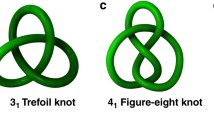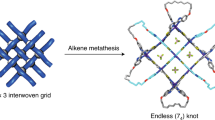Abstract
Simple and efficient synthetic routes to topologically complex mechanically interlocked molecules remain scarce owing to the sophisticated three-dimensional entanglement of their structures. We report herein the coordination-driven self-assembly from a trefoil knot to a structure comprising two interlocked homochiral trefoil knots by increasing the length of the ligands. The quadruple interlocking of two trefoil knots of the same handedness gives the resulting molecular prime double trefoil link with a total of 14 crossings. Molecular trefoil knots of single topological chirality are formed via enantiopure ligands. Likewise, a pair of topological enantiomers of the double trefoil link are separately and stereoselectively constructed through chirality transfer from the constituent ligands. The synthesis and topological chirality of the trefoil knot and the double trefoil link have been confirmed using single-crystal X-ray diffraction, mass spectrometry, NMR spectroscopy and circular dichroism spectroscopy. Construction of molecular links from non-trivial knots rather than just trivial macrocycles provides a synthetic strategy for topologically complex mechanically interlocked molecules.

This is a preview of subscription content, access via your institution
Access options
Subscribe to this journal
Receive 12 digital issues and online access to articles
$119.00 per year
only $9.92 per issue
Buy this article
- Purchase on Springer Link
- Instant access to full article PDF
Prices may be subject to local taxes which are calculated during checkout




Similar content being viewed by others
Data availability
Crystallographic data for the structures reported in this Article are available from the Cambridge Crystallographic Data Centre with the following codes: Δ-1 (CCDC 2143574), Λ2-2 (CCDC 2143575) and Δ2-2 (CCDC 2143576). Other data that support the findings of this study are available in the paper and Supplementary Information.
References
Lu, C. H., Cecconello, A. & Willner, I. Recent advances in the synthesis and functions of reconfigurable interlocked DNA nanostructures. J. Am. Chem. Soc. 138, 5172–5185 (2016).
Dabrowski-Tumanski, P. & Sulkowska, J. I. Topological knots and links in proteins. Proc. Natl Acad. Sci. USA 114, 3415–3420 (2017).
Ashley, C. W. The Ashley Book of Knots (Faber and Faber, 1993).
Bruns, C. J. & Stoddart, J. F. The Nature of the Mechanical Bond: From Molecules to Machines (Wiley, 2016).
Siegel, J. S. Driving the formation of molecular knots. Science 338, 752–753 (2012).
Fielden, S. D. P., Leigh, D. A. & Woltering, S. L. Molecular knots. Angew. Chem. Int. Ed. 56, 11166–11194 (2017).
Sawada, T. & Fujita, M. Folding and assembly of metal-linked peptidic nanostructures. Chem 6, 1861–1876 (2020).
Frank, M., Johnstone, M. D. & Clever, G. H. Interpenetrated gage structures. Chem. Eur. J. 22, 14104–14125 (2016).
Inomata, Y., Sawada, T. & Fujita, M. Metal-peptide torus knots from flexible short peptides. Chem 6, 294–303 (2020).
Leigh, D. A. et al. A molecular endless (74) knot. Nat. Chem. 13, 117–122 (2021).
Mahadevi, A. S. & Sastry, G. N. Cooperativity in noncovalent interactions. Chem. Rev. 116, 2775–2825 (2016).
Jamieson, E. M. G., Modicom, F. & Goldup, S. M. Chirality in rotaxanes and catenanes. Chem. Soc. Rev. 47, 5266–5311 (2018).
Fenlon, E. E. What tangled webs we weave. Nat. Chem. 10, 1078–1079 (2018).
Carpenter, J. P. et al. Controlling the shape and chirality of an eight-crossing molecular knot. Chem 7, 1534–1543 (2021).
Gil-Ramírez, G., Leigh, D. A. & Stephens, A. J. Catenanes: fifty years of molecular links. Angew. Chem. Int. Ed. 54, 6110–6150 (2015).
Zhang, L. et al. Stereoselective synthesis of a composite knot with nine crossings. Nat. Chem. 10, 1083–1088 (2018).
Sawada, T., Inomata, Y., Shimokawa, K. & Fujita, M. A metal–peptide capsule by multiple ring threading. Nat. Commun. 10, 5687 (2019).
Gao, W. X., Feng, H. J., Guo, B. B., Lu, Y. & Jin, G. X. Coordination-directed construction of molecular links. Chem. Rev. 120, 6288–6325 (2020).
Forgan, R. S., Sauvage, J. P. & Stoddart, J. F. Chemical topology: complex molecular knots, links, and entanglements. Chem. Rev. 111, 5434–5464 (2011).
Perret-Aebi, L. E., von Zelewsky, A., Dietrich-Buchecker, C. & Sauvage, J. P. Stereoselective synthesis of a topologically chiral molecule: the trefoil knot. Angew. Chem. Int. Ed. 43, 4482–4485 (2004).
Feigel, M., Ladberg, R., Engels, S., Herbst-Irmer, R. & Frohlich, R. A trefoil knot made of amino acids and steroids. Angew. Chem. Int. Ed. 45, 5698–5702 (2006).
Leigh, D. A., Pirvu, L. & Schaufelberger, F. Stereoselective synthesis of molecular square and granny knots. J. Am. Chem. Soc. 141, 6054–6059 (2019).
Greenfield, J. L. & Nitschke, J. R. Self-assembly of double-helical metallopolymers. Acc. Chem. Res. 55, 391–401 (2022).
Zhang, D. et al. Templation and concentration drive conversion between a FeII12L12 pseudoicosahedron, a FeII4L4 tetrahedron, and a FeII2L3 helicate. J. Am. Chem. Soc. 144, 1106–1112 (2022).
Sun, Y., Chen, C., Liu, J. & Stang, P. J. Recent developments in the construction and applications of platinum-based metallacycles and metallacages via coordination. Chem. Soc. Rev. 49, 3889–3919 (2020).
Ponnuswamy, N., Cougnon, F. B., Clough, J. M., Pantos, G. D. & Sanders, J. K. Discovery of an organic trefoil knot. Science 338, 783–785 (2012).
Caprice, K. et al. Diastereoselective amplification of a mechanically chiral [2]catenane. J. Am. Chem. Soc. 143, 11957–11962 (2021).
Fenlon, E. E. Open problems in chemical topology. Eur. J. Org. Chem. 2008, 5023–5035 (2008).
Katsonis, N. et al. Knotting a molecular strand can invert macroscopic effects of chirality. Nat. Chem. 12, 939–944 (2020).
Acknowledgements
This work was supported by the National Science Foundation of China (22031003 and 21720102004 (G.-X.J.)) and the Shanghai Science Technology Committee (19DZ2270100 (G.-X.J.)).
Author information
Authors and Affiliations
Contributions
Z.C. and G.-X.J. designed the experimental protocol. Z.C. performed the synthesis and characterization studies, solved the crystal structure and wrote the manuscript. G.-X.J. directed the research. Z.C. and G.-X.J. analysed the experimental results and revised the manuscript.
Corresponding author
Ethics declarations
Competing interests
The authors declare no competing interests.
Peer review
Peer review information
Nature Synthesis thanks Kari Rissanen and the other, anonymous, reviewer(s) for their contribution to the peer review of this work. Primary Handling editor: Alison Stoddart, in collaboration with the Nature Synthesis team.
Additional information
Publisher’s note Springer Nature remains neutral with regard to jurisdictional claims in published maps and institutional affiliations.
Supplementary information
Supplementary Information
Supplementary Tables 1 and 2, Figs. 1–55, experimental details, X-ray crystallographic details and refs. 1–41.
Supplementary Data 1
Crystallographic data for Δ-1 (CCDC 2143574).
Supplementary Data 2
Crystallographic data for Λ2-2 (CCDC 2143575).
Supplementary Data 3
Crystallographic data for Δ2-2 (CCDC 2143576).
Rights and permissions
About this article
Cite this article
Cui, Z., Jin, GX. Construction of a molecular prime link by interlocking two trefoil knots. Nat. Synth 1, 635–640 (2022). https://doi.org/10.1038/s44160-022-00094-5
Received:
Accepted:
Published:
Issue Date:
DOI: https://doi.org/10.1038/s44160-022-00094-5
This article is cited by
-
The sharp structural switch of covalent cages mediated by subtle variation of directing groups
Nature Communications (2023)
-
Double, double trefoil and trouble
Nature Synthesis (2022)



